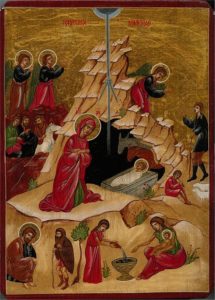2018 New Testament Apocrypha Course: Reflections on Week Three
This week’s class focused on Infancy Gospels, with particular emphasis on the Infancy Gospel of James and the Infancy Gospel of Thomas, the earliest examples of this literature. We began, however, with a discussion of the infancy narratives of Matthew and Luke. It helps considerably to have the students spend some time discussing canonical texts, in part so they can see what the noncanonical texts do with the earlier traditions and also because some students come into the course without any knowledge of Christian texts, biblical or otherwise. So we read Matthew 1-2 together and noted its similarities and differences with Luke 1-2. The differences are particularly significant as infancy gospels like Infancy James must confront these differences in the process of harmonizing the two accounts. I discussed also the reference to Jesus’ brothers and sisters (and lack of mention of Joseph) in Mark 6:3 and the anti-Christian polemic in Celsus’s True Doctrine, the Talmud, and the Toledot Yeshu (all in anticipation of our examination of Infancy James).

For Infancy James we looked first at a segment from the documentary Banned From the Bible (History Channel, 2003), which helped students recall the contents of the text and opened up conversation on some of the interpretations and implications of the text. I emphasized in our discussion that there are several features of the text that have become integral to Christian teaching about Mary, including the Doctrine of the Immaculate Conception, the Doctrine of the Perpetual Virginity, the names of Mary’s parents, and the presence of Salome in Greek Orthodox depictions of the nativity scene. In discussing the cave of the nativity, we briefly touched on the relationship between apocryphal traditions and pilgrimage sites (for more on this see my three posts on pilgrimage, beginning HERE). One student asked what was known about Christian pilgrimage sites in the first few centuries. I could only recall Justin’s mention of the cave (see Dial. 78) and perhaps grave sites of early saints. As far as I am aware, all other sites were established after Constantine.
It’s widely known (I think) that I have a soft spot for Infancy Thomas—it was the focus of my doctoral dissertation and several additional published works. I’m not alone in my appreciation for this text; many scholars enjoy introducing it to students because it is one of the more outlandish texts of the Christian Apocrypha. As my students said, Jesus is here portrayed as a “brat” and a “murderer.” As I often do with discussions of this text, I tried to convince the students that Infancy Thomas’s portrayal of Jesus would not be so problematic in antiquity and that late-antique objections to the text were about how it contradicts John’s declaration that Jesus’ first miracle was at Cana, not because its cursing Jesus was offensive and inappropriate. I brought into the discussion the use of the story of Jesus animating the birds (Infancy Thomas 3) in the Qur’an and the Toledot Yeshu (noting that it seems to be a story well-known even to outsiders to and critics of Christianity); we also looked at an adaptation of the story of Jesus killing a boy in the marketplace (Infancy Thomas 4) in the Young Messiah, based on the first book in Anne Rice’s Christ the Lord series. I pointed out how the film tries to “clean up” the story—Jesus does not curse the boy, instead a Satan figure makes him fall and incites the crowd to blame Jesus—and how these efforts are similar to the addition of miracle stories to the Infancy Thomas manuscript tradition.
We finished up the class with a quick look at later infancy gospels, such as the Gospel of Pseudo-Matthew, the Book of the Birth of the Savior (aka M. R. James’s Latin Infancy Gospel), the Syriac Life of the Virgin (known in Arabic translation as the Arabic Infancy Gospel), and the Armenian Infancy Gospel. I assigned also a summary of the Revelation of the Magi but we had little time to discuss it. I intended to show a video of Brent Landau discussing his translation of the text; I have embedded it here in case readers would like to see it. The last text mentioned was On the Priesthood of Jesus, in which Mary’s claims of perpetual virginity are confirmed by midwives (recalling Salome’s gynecological examination of Mary in Infancy James).
Clearly Christian literature is rich with stories of Jesus’ childhood and infancy (and Mary’s too). The lecture could easily have been expanded to two classes. Next week we turn to texts focusing on Jesus’ adult career.
